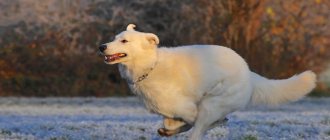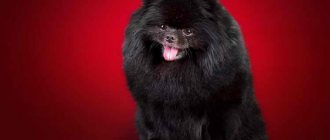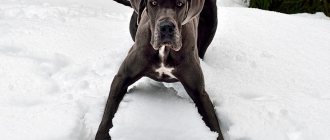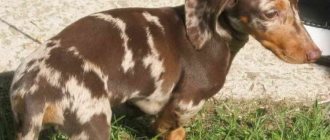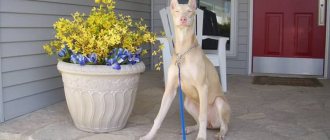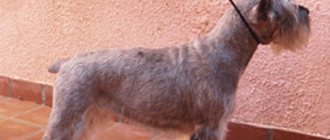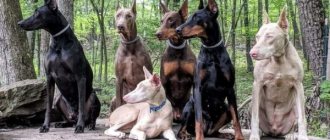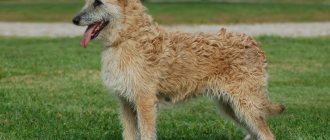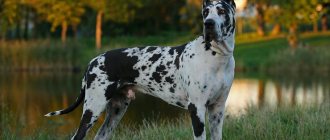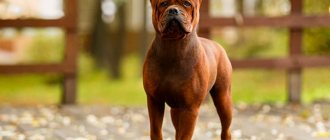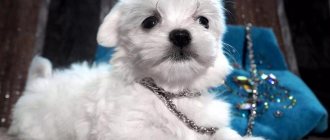Many dog experts are of the opinion that the Landseer is a type of Newfoundland. However, in the middle of the 17th century it was decided to introduce the breed into a separate standard. As is commonly believed, the Landseer breed was developed thanks to English noblemen who crossed the Newfoundland and the British dog, now considered extinct. The mixing of the two breeds was able to produce the so-called black and white variety of Newfoundland, accounting for 18% of the total population. This cute breed was named after an artist named Edwin Henry Landseer, who is famous for his paintings of these beautiful black and white Newfoundlands. Since that time, the breed has gained its popularity.
Description and standard of the Landseer breed
Height at withers: 67-80 cm Weight: 50-60 kg
Color: spotted. The base color is white, on which symmetrical spots of black are scattered. On the back there are spots in the shape of a cloak or saddle; the head can be completely black with a white blaze. Speckling is allowed on the paws, and frost on the face. If the Landseer has been in the sun for a long time, then a reddish-brown coating may appear on the black spots.
- The coat is thick, long, harsh to the touch, forms feathers and trousers on the paws, a mane on the neck, and no dewlap on the tail. On the back, a parting is sometimes formed along the spine. The undercoat is soft and thick, does not get wet in water.
- Sexual dimorphism is pronounced: males are larger than females and more courageous than females.
- The physique is muscular, with a stretched format, a straight back and a broad chest.
- The “bear” head is wide, rounded in the skull, with a short muzzle and developed cheekbones. The shape resembles a blunt wedge.
- The ears are drooping with rounded ends, set high and close to the cheeks.
- The eyes are small, oval, hazel or brown in color.
- The nose is wide and black.
- The tail is long, thick, the dog carries it like a sickle at the level of the back, and lowers it down when calm.
Dossier
Adult height: males - 72-80 cm, females - 67-72 cm. Weight: males - 59-68 kg, females - 45-54 kg. Characteristic color: white with black areas around the head, belly and lower back. Coat Length: Long, thick coat. Life expectancy: 10-12 years. Advantages of the breed: excellent health, kind, calm character and love for children. Difficulties of the breed: the coat requires careful care, the dog eats a lot and, due to its size, is not suitable for every apartment. Average price: 1800-2200 dollars depending on the nursery and pedigree. Classification: large companion or rescue dog.
History of the breed
The history of the breed began in Germany and Switzerland. Although there is a version that this breed originated on the island of Newfoundland. The ancestor is considered to be the pet of St. John, who knew how to swim and fish perfectly. Therefore, the Landseer loves water from birth and is ready to spend a lot of time in it.
In the 18th century, dogs of this breed came to England, where they were popular and mistakenly recognized as the English version of the Newfoundland.
The name of the breed is the surname of the artist Edwin Landseer, who depicted black and white dogs in his canvases. Therefore, for a long time Landseers were called “Landseer Newfoundlands”. Landseers were also mentioned in literature, Byron wrote about them.
"A Worthy Member of the Humane Society" by Edwin Landseer
"Saved" by Edwin Landseer
At the beginning of the twentieth century, Landseers almost disappeared - they were saved by German fans who crossed representatives of the breed with the Pyrenean mountain dog. In the mid-twentieth century, the breed was officially recognized by the International Canine Federation, but some kennel clubs still consider the Landseer to be a black and white version of the Newfoundland.
Previously, Landseers were used by fishermen: the dog helped them pull nets full of fish out of the water. Today these are rescue dogs, carriers of game during hunting, and companions.
How to choose a puppy
It is best to purchase a puppy from a kennel, as this will give you an almost 100% chance of getting a physically healthy and mentally balanced dog with a good pedigree. It is necessary to look at the puppy and its parents. They should be friendly and non-aggressive. The puppy itself should be moderately well-fed, curious, cheerful and easy to get along with. He should have clear brown eyes without streaks, a cold, wet nose; the paws and back should be straight, without curvatures or deflections, and there should be no hernias.
Attention! It must be remembered that the first month of separation of a puppy from its mother is the most difficult in its life (high mortality rate).
You need to choose the right diet, full of proteins, and not leave the puppy alone, as he can become very bored.
The Landseer breed standard is:
- massive, proportional torso with strong muscles;
- powerful massive neck and deep chest with large muscles;
- strong limbs;
- there are well-developed membranes on the paws, which allows dogs to swim well;
- ears are hanging, triangular, set high;
- the coat is thick, dense, soft to the touch;
- the color is symmetrical: the belly, chest and tail are white, there are black spots on the body; the head is either completely black or with white clearings.
What to pay attention to
The high price and the breeder’s assurances of the purebred of the breed are not a guarantee that the puppy will turn out to be a Landseer, and not a black and white Newfoundland at best, and just a motley mestizo, or even a mongrel, at worst. The only thing that can serve as confirmation of the breed is the puppy’s metric. Based on this, it is recommended to buy Landseers only from trusted nurseries or from a reliable breeder.
When choosing a puppy, experts recommend paying attention to the following signs of health and quality breeding:
- A healthy puppy is active, moderately curious and playful.
- He looks well-fed, but not overfed.
- Protruding ribs and visible thinness are also unacceptable: they may be a sign of some serious illness.
- A healthy puppy has clear, clean eyes without discharge, shiny coat without bald spots and skin without signs of redness or rashes.
At the age of 2-3 months, it is impossible to predict how a dog will grow up, and yet when choosing, you should pay attention to the compliance of its appearance with the breed standard for those external features that will not change over time or will change little. These include: color, bite, eye color, pigmentation of the nose and lips, posture, shape and size of the ears, straightness and posture of the limbs, and, most importantly, harmonious build.
Important! Small puppies look more squat than adult animals, but still the disharmony of build noticeable at this age will most likely make itself felt in the future, when the dog grows up.
Price of a purebred puppy
The cost of a purebred Landseer puppy starts from 35,000-40,000 rubles, but depending on the origin and class (pet, breed, show) it can reach 100,000 or more. For a dog purchased from a foreign kennel, you will most likely have to pay even more. Prices for puppies of this breed depend on the season and in the summer, during the holidays, it may be significantly lower than before the New Year holidays. It also happens that breeders sell already grown puppies cheaper.
Behavior and temperament
Landseer is a confident, calm, good-natured dog. He behaves with dignity and does not lose “face” in a difficult situation. You can safely rely on Landseer.
Pros:
- communicative;
- friendly;
- devoted;
- brave;
- obedient;
- security guard-diplomat, not prone to aggression;
- well trained.
Minuses:
- does not protect the territory;
- doesn't like to be alone;
- loves water so much that he will not miss a single chance to get into it.
Character
The character of Landseer dogs is very kind. Dogs love people and cannot do without their company, since the breed was originally bred as a human assistant. Landseers adore children and will never hurt them. At the same time, dogs are very brave and will be willing to risk their lives for the sake of their owner. In addition, these animals exhibit a high level of intelligence and, despite their size, have grace and elegance. They love water very much, so they will pay attention to every puddle and want to swim in a body of water suitable for them.
Dog and man
Landseer is a big and kind bear. He is calm, but will not refuse to have fun. You can have such a dog as a companion and family friend, a travel colleague. But the Landseer is not suitable as a watchman - he is too good-natured and trusting for this role. He doesn't like loneliness , so he shouldn't be left alone in the house for a long time.
Landseer is not aggressive and loves children , he knows how to handle them carefully, but at the same time easily joins in fun games and patiently endures children's antics. The main thing is to ensure that the child does not offend the pet.
The Landseer gets along well with other animals, considering them part of his family. But it is important to socialize the puppy early.
Choosing a nickname
A name that is suitable for a Landseer is a sonorous nickname that can phonetically convey the dog’s strength and confidence, but at the same time emphasize its good disposition.
Nicknames for males: Golden, Leader, Olympus, Trevor, Remo. Nicknames for bitches: Gary, Marta, Panda, Mishka, Zeya.
Maintenance and care
This is a difficult dog to keep, especially in a city apartment. Considerable size, a large amount of long hair, the smell of a dog and slobbering make the dog not the best roommate. But if you wish, you can put up with these disadvantages.
The key to success is long and active walks, keeping the animal constantly busy. Walk your Landseer every day for 2-3 hours a day . 2-3 walks a day are enough for the dog.
Landseer does not tolerate heat - the pet should always be able to hide from the scorching sun. He likes a cool climate, this dog is suitable for living outside in a booth or enclosure - the thick undercoat will prevent him from freezing. But by putting a Landseer on a chain, you risk making him an embittered and inadequate creature instead of a good-natured giant.
The ideal conditions for keeping a Landseer are a private house with a spacious local area and a swimming pool, where the dog can bathe to his heart's content.
Landseer puppies eat a lot as they grow, so be prepared to spend a lot of money on feeding the baby. chondroprotectors and vitamins with calcium for your puppy : puppies grow quickly, and their skeleton needs support during development.
Adults are more restrained in the amount of food they eat and eat little for their size. Landseer is unpretentious in food, but when creating a menu, keep in mind that the main part of the diet is lean meat and sea fish, taken from the bones. Cottage cheese, fermented milk products, vegetables and fruits will be useful. If you feed your dog dry food, choose premium food.
Since the Landseer loves water, you will have to carefully care for the coat: after bathing, the dog collects dirt on itself. It is important to constantly brush the coat , especially if you live in a city apartment: Landseers shed profusely.
Regularly examine your dog's eyes and ears and clean them as they become dirty. The claws usually wear down naturally on the ground and asphalt, but trimming may also be necessary, so watch the length of the claws and trim them in time with a nail clipper.
Nutrition
Landseer requires a significant amount of food, so before purchasing, make sure you are able to feed the dog. A puppy will need a particularly large amount of food. It should be remembered that there are a number of products for the breed that are strictly prohibited:
- pork (very fatty meat that can cause poisoning);
- potatoes (causes poor digestion);
- semolina porridge (causes stomach upset);
- sweets (provokes inflammation of the eyes);
- smoked and pickled (negatively affects the liver);
- bones from fish and poultry (can clog the stomach and harm the esophagus).
Remember that nutrition should be balanced and healthy. Add various vitamin complexes to your dishes.
See also: Caucasian Shepherd Dog
Education and training
Landseer is understanding and smart, but sometimes stubborn. easy to train , especially if you develop natural qualities through training: the desire to please a person and follow him.
Don’t think that you will be able to raise a Landseer to be a watchman, but he will make an excellent companion When training, use the method of positive reinforcement - rudeness towards Landseer is unacceptable.
It’s good if you figure out how to spend your free time with your dog, combining training and walks. Travel, go to bodies of water, teach your dog to accompany you on a jog or bike ride, walk in the forests.
Purpose
Despite its gigantic size, the dog is not well suited for home guarding due to its kind nature and love for people. The Landseer will be an excellent companion dog for a family, a rescue dog in mountainous areas or near-water environments, as its thick fur will prevent it from freezing, and well-developed webbed feet make the Landseer an excellent swimmer.
